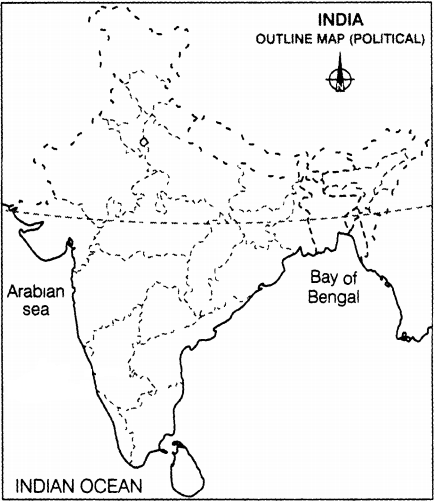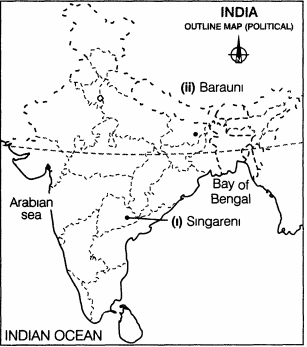Ch17 India Mineral and Energy Resources - Test Papers
CBSE Test Paper 01
- Name the sources of non-conventional energy.
- Name the areas where natural gas is found.
- When was the first Atomic Energy Commission established and where?
- Solar energy is the hope of future. Discuss.
- Name the agencies involved in exploration of minerals
- Differentiate between ferrous and non-ferrous minerals.
- Why is conservation of minerals essential in India? How can we conserve them? Explain in two points.
- Describe the uneven distribution of mineral and energy resources in India by giving suitable examples.
- How is wind energy a better source of energy? What achievements have been made by India in the field of wind energy?
- On the given political outline map of India, locate and label the following with appropriate symbols.
- Singareni coal mines.
- An oil refinery located in Bihar.

CBSE Test Paper 01
Ch-17 India Mineral and Energy Resources
Answer
- The sources of non-conventional energy are:
- Solar energy
- Wind energy
- Tidal and wave energy
- Geo-thermal
- Bio-energy
- Almost 70% of India's natural gas reserves are found in the Bombay High basin and in Gujarat. Offshore gas reserves are also located in Andhra Pradesh coast (Krishna Godavari Basin) and Tamil Nadu coast (Cauvery Basin). Onshore reserves are located in Gujarat and the North Eastern states (Assam and Tripura).
- The Atomic Energy Commission is the governing body of the Department of Atomic Energy (DAE), Government of India. The Indian Atomic Energy Commission was set up on 3 August 1948 under the late Department of Scientific Research in Mumbai.
- Solar energy is the hope of future because it is:
- Cost competitive--Technological developments and policy and subsides by the government have reduced the high costs of solar systems. The running costs are less and the initial investment is regained leading to subsequent savings in energy costs
- Environment friendly--Solar is a safe alternative which can replace current fossil fuels like coal and gas for generation of electricity that produce air, water, and land pollution.Solar power can restrict climate change as it produces no carbon emissions.
- In India, systematic surveying, prospecting and exploration for minerals is undertaken by the Geological Survey of India (GSI), Central Mine Planning and Design Institute (CMPDI), Oil and Natural Gas Corporation (ONGC)Mineral Exploration Corporation Limited (MECL), National Mineral Development Corporation(NMDC), Indian Bureau of Mines (IBM), Bharat Gold Mines Limited (BGML), Hindustan Copper Limited (HCL), National Aluminium Company Limited (NALCO) and the Departments of Mining and Geology in various states. The Centre for Techno-Economic Mineral Policy Options (C-TEMPO)is a think tank under the Ministry of Mines which looks at the national exploration policy
Basis Ferrous Minerals Non-ferrous Minerals Meaning Ferrous minerals are naturally occurring inorganic substances that contain iron (Fe) as an element in the composition.
Nonferrous minerals are naturally occurring inorganic substances that do not contain iron (Fe) as an element in the composition.
Properties Ferrous Minerals are magnetic and give little resistance to corrosion. Non-ferrous are not magnetic and are usually more resistant to corrosion than ferrous metals. Example Iron ore, manganese, chromite, etc. Copper, bauxite, iron, gold, etc. Conservation of minerals is more important than other resources due to the following reasons:
- Minerals are important to conserve as industries and agriculture are dependent completely on minerals and the substance manufactured from them.
- We are rapidly consuming mineral resources that require millions of years to be renewed.
There are some methods through which we can conserve mineral resources:
- Adoption of renewable resources in place of exhaustible resources like solar power, wind, wave, geothermal energy can save our non-renewable resources.
- Use of recycled scrap metals should be encouraged. It can save the mining of metals.
India is a rich country in terms of minerals. Most of the metallic minerals occur in the Peninsular Plateau region in the old crystalline rocks. River valleys of Damodar, Sone, Mahanadi and Godavari have over 97% of coal reserves in India.
Sedimentary basins of Assam and off-shore regions in the Arabian Sea (Gujarat and Mumbai High) are famous for their crude petroleum reserves. The area to the east of a line linking Mangalore and Kanpur has most of the major mineral resources of India.
Mineral are mainly concentrated in three broad belts, namely:- The North-Eastern Plateau region
- The South-Western Plateau region
- The North-Western region
Benefits of wind energy:
- Wind power, as an alternative to burning fossil fuels, is plentiful, renewable, widely distributed, clean, produces no greenhouse gas emissions during operation, consumes no water, and uses little land.
- Wind power gives variable power, which is very consistent from year to year but has significant variation over shorter time scales. It is therefore used in conjunction with other electric power sources to give a reliable supply.
Achievements of India:
- India has started generating wind energy. It has installed some of the wind energy plants.
- It has an ambitious programme to install 250 wind-driven turbines with a total capacity of 45 megawatts, spread over 12 suitable locations, especially in coastal areas.
- According to the estimation by Ministry of Power, India will be able to produce 3,000 megawatts of electric from this source.
- The Ministry of non-conventional sources of energy is developing wind energy in India to lessen the burden of oil import bill.
- The country's potential of wind power generation exceeds 50,000 megawatts, of which one fourth can be easily harnessed.
- The Government of Tamil Nadu realized the importance and need for renewable energy, and set up a separate Agency, as registered society, called the Tamil Nadu Energy Development Agency (TEDA) as early as 1985. Now, Tamil Nadu has become a leader in Wind Power in India. In Muppandal windfarm, the total capacity is 1500 MW, the largest wind power plant in India. The total wind installed capacity in Tamil Nadu is 7633 MW. During the fiscal year 2014-15, the electricity generation is 9.521 GWh, with about a 15% capacity utilization factor.
- There are 50 developers registered with state nodal agency "Maharashtra energy Development Agency" for development of wind power projects. All the major manufacturers of wind turbines including Suzlon, Vestas, Gamesa, Regen, Leitner Shriram have presence in Maharashtra.
- ONGC Ltd. has installed a 51MW wind energy farm at Bhuj in Gujarat. Renewable energy projects worth a massive Rs 1 lakh crore of memorandums of understanding (MoUs) in the Vibrant Gujarat Summit in 2017.
- In consideration of unique concept, Govt. of Madhya Pradesh has sanctioned another 15 MW project to Madhya Pradesh Windfarms Ltd. MPWL, Bhopal at Nagda Hills near Dewas under consultation from Consolidated Energy Consultants Ltd. CECL Bhopal.

